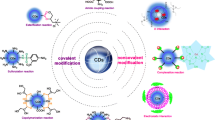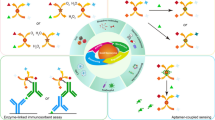Abstract
Water-soluble and non-aggregating gold nanoclusters (AuNCs) were obtained by modification of the AuNCs with dithiothreitol (DTT) and then coating them with carboxylated chitosan. This process remarkably enhances the dispersibility of DTT-coated AuNCs in water. The resulting AuNCs, on photoexcitation at 285 nm, display strong red emission with a maximum at 650 nm and a 23% quantum yield. Fluorescence is strongly and selectively suppressed in the presence of 6-mercaptopurine (6-MP). Photoluminescence drops linearly in the 0.1–100 μM 6-MP concentration range, and the detection limit of this assay is 0.1 μM. Other features of the modified AuNCs include a decay time of 8.56 μs, a 365 nm Stokes shift, good colloidal stability, ease of chemical modification, and low toxicity. Conceivably, these NCs may find a range of applications in biological imaging and optical sensing.

Highly fluorescent and water-soluble gold nanoclusters (AuNCs) were obtained by modification of the AuNCs with dithiothreitol (DTT) and then coating them with carboxylated chitosan (CC). The resulting CC/DTT-AuNCs were used for sensitive and selective detection of 6-mercaptopurine.







Similar content being viewed by others
References
Sahasranaman S, Howard D, Roy S (2008) Clinical pharmacology and pharmacogenetics of thiopurines. Eur J Clin Pharmacol 64(8):753–767
Lennard L (1999) Therapeutic drug monitoring of antimetabolic cytotoxic drugs. Br J Clin Pharmacol 47(2):131–143
Erdmann GR, France LA, Bostrom BC, Canafax DM (1990) A reversed phase high performance liquid chromatography approach in determining total red blood cell concentrations of 6-thioguanine, 6-mercaptopurine, methylthioguanine, and methylmercaptopurine in a patient receiving thiopurine therapy. Biomed Chromatogr 4(2):47–51
Hawwa AF, Millership JS, Collier PS, McElnay JC (2009) Development and validation of an HPLC method for the rapid and simultaneous determination of 6-mercaptopurine and four of its metabolites in plasma and red blood cells. J Pharm Biomed Anal 49(2):401–409
Rudy J, Argyle J, Winick N, Van Dreal P (1988) HPLC analysis of 6-mercaptopurine and metabolites in extracellular body fluids. Ann Clin Biochem 25(5):504–509
O'Shea TJ, Lunte SM (1993) Selective detection of free thiols by capillary electrophoresis-electrochemistry using a gold/mercury amalgam microelectrode. Anal Chem 65(3):247–250
Rosenfeld J, Taguchi V, Hillcoat B, Kawai M (1977) Determination of 6-mercaptopurine in plasma by mass spectrometry. Anal Chem 49(6):725–727
Yang P, Chen Y, Zhu Q, Wang F, Wang L, Li Y (2008) Sensitive chemiluminescence method for the determination of glutathione, L-cysteine and 6-mercaptopurine. Microchim Acta 163(3–4):263–269
Sun H, Wang T, Liu X, Chen P (2013) A sensitive inhibition chemiluminescence method for the determination of 6-mercaptopurine in tablet and biological fluid using the reaction of luminol-ag (III) complex in alkaline medium. J Lumin 134:154–159
Biparva P, Abedirad SM, Kazemi SY (2015) Silver nanoparticles enhanced a novel TCPO-H2O2-safranin O chemiluminescence system for determination of 6-mercaptopurine. Spectrochim Acta A 145:454–460
Karimi-Maleh H, Tahernejad-Javazmi F, Atar N, Yola MLT, Gupta VK, Ensafi AA (2015) A novel DNA biosensor based on a pencil graphite electrode modified with polypyrrole/functionalized multiwalled carbon nanotubes for determination of 6-mercaptopurine anticancer drug. Ind Eng Chem Res 54(14):3634–3639
Shahrokhian S, Ghorbani-Bidkorbeh F, Mohammadi A, Dinarvand R (2012) Electrochemical determinations of 6-mercaptopurine on the surface of a carbon nanotube-paste electrode modified with a cobalt salophen complex. J Solid State Electrochem 16(4):1643–1650
Keyvanfard M, Khosravi V, Karimi-Maleh H, Alizad K, Rezaei B (2013) Voltammetric determination of 6-mercaptopurine using a multiwall carbon nanotubes paste electrode in the presence of isoprenaline as a mediator. J Mol Liq 177:182–189
Lu BY, Li H, Deng H, Xu Z, Li WS, Chen HY (2008) Voltammetric determination of 6-mercaptopurine using [co(phen)3]3+/MWNT modified graphite electrode. J Electroanal Chem 621(1):97–102
Gao MX, Xu JL, Li YF, Huang CZ (2013) A rapid and sensitive spectrofluorometric method for 6-mercaptopurine using CdTe quantum dots. Anal Methods 5(3):673–677
Chen Z, Zhang G, Chen X, Chen J, Liu J, Yuan H (2013) A fluorescence switch sensor for 6-mercaptopurine detection based on gold nanoparticles stabilized by biomacromolecule. Biosens Bioelectron 41:844–847
Shen XC, Jiang LF, Liang H, Lu X, Zhang LJ, Liu XY (2006) Determination of 6-mercaptopurine based on the fluorescence enhancement of au nanoparticles. Talanta 69(2):456–462
Bi N, Hu M, Xu J, Jia L (2017) Colorimetric determination of mercury(II) based on the inhibition of the aggregation of gold nanorods coated with 6-mercaptopurine. Microchim Acta 184(10):3961–3967
Yao Q, Yuan X, Fung V, Yu Y, Leong DT, Jiang D, Xie J (2017) Understanding seed-mediated growth of gold nanoclusters at molecular level. Nat Commun 8(1):927
Yao Q, Fung V, Sun C, Huang S, Chen T, Jiang DE, Lee JY, Xie J (2018) Revealing isoelectronic size conversion dynamics of metal nanoclusters by a noncrystallization approach. Nat Commun 9(1):1979
Deng HH, Zhang LN, He SB, Liu AL, Li GW, Lin XH, Xia XH, Chen W (2015) Methionine-directed fabrication of gold nanoclusters with yellow fluorescent emission for Cu2+ sensing. Biosens Bioelectron 65:397–403
Deng HH, Wu GW, Zou ZQ, Peng HP, Liu AL, Lin XH, Xia XH, Chen W (2015) pH-sensitive gold nanoclusters: preparation and analytical applications for urea, urease, and urease inhibitor detection. Chem Commun 51(37):7847–7850
Shang L, Dörlich RM, Brandholt S, Schneider R, Trouillet V, Bruns M, Gerthsen D, Nienhaus GU (2011) Facile preparation of water-soluble fluorescent gold nanoclusters for cellular imaging applications. Nanoscale 3(5):2009–2014
Deng HH, Shi XQ, Wang FF, Peng HP, Liu AL, Xia XH, Chen W (2017) Fabrication of water-soluble, green-emitting gold nanoclusters with a 65% photoluminescence quantum yield via host-guest recognition. Chem Mater 29(3):1362–1369
Deng HH, Wang FF, Shi XQ, Peng HP, Liu AL, Xia XH, Chen W (2016) Water-soluble gold nanoclusters prepared by protein-ligand interaction as fluorescent probe for real-time assay of pyrophosphatase activity. Biosens Bioelectron 83:1–8
Shen J, Jin B, Qi YC, Jiang QY, Gao XF (2017) Carboxylated chitosan/silver-hydroxyapatite hybrid microspheres with improved antibacterial activity and cytocompatibility. Mater Sci Eng C 78:589–597
Ding H, Liang C, Sun K, Wang H, Hiltunen JK, Chen Z, Shen J (2014) Dithiothreitol-capped fluorescent gold nanoclusters: an efficient probe for detection of copper (II) ions in aqueous solution. Biosens Bioelectron 59:216–220
Wu Z, Jin R (2010) On the ligand’s role in the fluorescence of gold nanoclusters. Nano Lett 10(7):2568–2573
Yuan X, Luo Z, Yu Y, Yao Q, Xie J (2013) Luminescent noble metal nanoclusters as an emerging optical probe for sensor development. Chem.-Asian J 8(5):858–871
Huang CC, Yang Z, Lee KH, Chang HT (2007) Synthesis of highly fluorescent gold nanoparticles for sensing mercury (II). Angew Chem 119(36):6948–6952
Shang L, Azadfar N, Stockmar F, Send W, Trouillet V, Bruns M, Gerthsen D, Nienhaus GU (2011) One-pot synthesis of near-infrared fluorescent gold clusters for cellular fluorescence lifetime imaging. Small 7(18):2614–2620
Jin M, Mou ZL, Zhang RL, Liang SS, Zhang ZQ (2017) An efficient ratiometric fluorescence sensor based on metal-organic frameworks and quantum dots for highly selective detection of 6-mercaptopurine. Biosens Bioelectron 91:162–168
Sun Z, Liu Y, Li Y (2015) Selective recognition of 6-mercaptopurine based on luminescent metal-organic frameworks Fe-MIL-88NH 2. Spectrochim Acta A 139:296–301
Zakrzewski R, Borowczyk K, Łuczak A, Młynarski W, Trelińska J (2013) Determination of urinary 6-mercaptopurine and three of its metabolites by HPLC-UV coupled with the iodine-azide reaction. Bioanalysis 5(8):869–877
Ensafi AA, Karimi-Maleh H (2012) Determination of 6-mercaptopurine in the presence of uric acid using modified multiwall carbon nanotubes-TiO2 as a voltammetric sensor. Drug Test Anal 4(12):970–977
Acknowledgments
The authors gratefully acknowledge the financial support of the National Natural Science Foundation of China (21675024, 21405126), the Program for Innovative Leading Talents in Fujian Province (2016B016), Joint Funds for the Innovation of Science and Technology, Fujian Province (2016Y9056), and the Natural Science Foundation of Fujian Province (2017 J01575, 2017 J01225).
Author information
Authors and Affiliations
Corresponding authors
Ethics declarations
The author(s) declare that they have no competing interests.
Electronic supplementary material
ESM 1
(DOCX 284 kb)
Rights and permissions
About this article
Cite this article
Deng, HH., Huang, KY., Zhuang, QQ. et al. Preparation of strongly fluorescent water-soluble dithiothreitol modified gold nanoclusters coated with carboxychitosan, and their application to fluorometric determination of the immunosuppressive 6-mercaptopurine. Microchim Acta 185, 400 (2018). https://doi.org/10.1007/s00604-018-2933-0
Received:
Accepted:
Published:
DOI: https://doi.org/10.1007/s00604-018-2933-0




